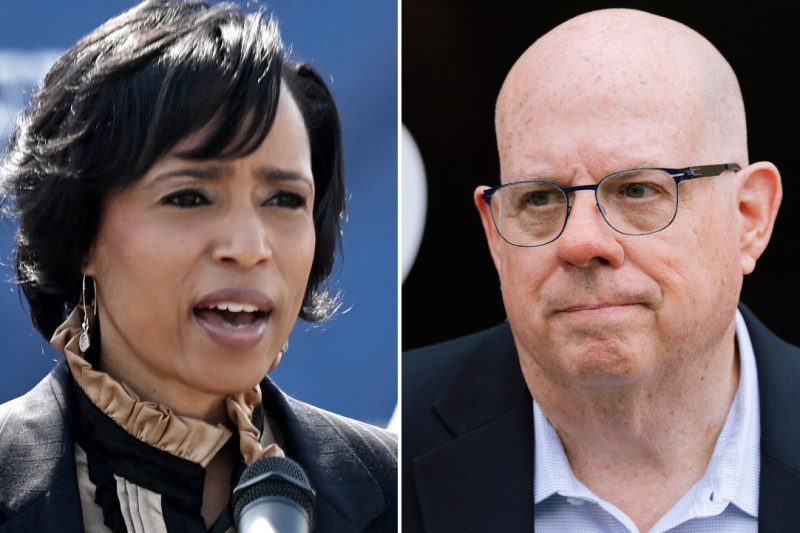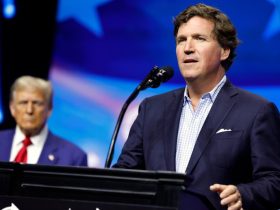Democrat Angela Alsobrooks has pulled clearly ahead in Maryland’s unusually competitive U.S. Senate race with a double-digit lead among likely voters, according to a Washington Post-University of Maryland poll, in a contest critical to deciding control of the chamber next year.
Alsobrooks leads Republican Larry Hogan — a former governor elected twice in the deep-blue state — by 11 percentage points among likely voters, even though the poll shows Hogan has won over a sizable portion of Democrats and remains about as popular with voters as his rival.
With tens of millions of dollars yet to be spent on the airwaves, a debate ahead and national attention locked on to the race, Alsobrooks’s 51 percent to 40 percent advantage is significant and demonstrates momentum, but it is not enough to put a Hogan upset out of the question.
Democrats outnumber Republicans in Maryland by more than 2 to 1. Independent voters, including those affiliated with the Green and Libertarian parties, make up nearly a quarter of the electorate and typically swing for Democratic candidates in presidential elections but have helped Republicans win three out of the last six governor’s races. Maryland is expected to give its 10 electoral college votes to Vice President Kamala Harris in November. The poll finds she leads former president Donald Trump 63 percent to 31 percent.
“The task for Alsobrooks is pretty challenging because a lot of Democrats have a favorable opinion of Hogan, and changing that is not necessarily easy,” said University of Maryland political scientist Michael Hanmer, director of the university’s Center for Democracy and Civil Engagement, which co-sponsored the poll. “I think she’s made a lot of headway.”
Maryland’s race is among a handful that could determine which party shapes the country’s agenda through control of the Senate, but it is the only deeply Democratic state in play and a close contest could siphon resources from swing states.
Maryland has not elected a Republican to the Senate in four decades and President Joe Biden won here by 33 percentage points in 2020. Yet, Hogan’s track record as a pragmatic, two-term governor with an anti-Trump brand — and a history of pulling off a big upset — has kept the race relatively competitive.
Democratic voters and moderates switching allegiance from Hogan to Alsobrooks have been key to Alsobrooks’s improved standing since March. Back then, early polling showed Hogan with a clear early advantage while Alsobrooks, the Prince George’s County executive, was unknown to most voters — despite leading one of the state’s largest jurisdictions. A Post-UMD poll then showed moderates favoring Hogan by 22 points; now they favor Alsobrooks by 16 points. In addition, Alsobrooks’s 20-point advantage among Democrats in March has swollen to a dominant 57-point margin over Hogan now.
Alsobrooks, who started her political career as the Prince George’s County prosecutor, has benefited from voters growing more familiar and fonder of her.
In particular, she’s benefited from lopsided support from the voters who want Democrats to control the U.S. Senate. Those voters — about 6 in 10 — have shifted decisively in support of Alsobrooks over the past six months: In March, 61 percent backed Alsobrooks and now 83 percent do.
Jay Anderson, 73 and a retiree who lives on Kent Island, is a swing voter who twice cast a ballot for Hogan for governor. This time, he’s voting for Alsobrooks out of concern over which party controls the Senate, he said.
“I like Larry Hogan. I voted for him. But I’m not comfortable with him being in the Senate because of what it might mean for the majority,” Anderson said. “I just fear having any kind of Republican influence in Congress.”
He added that he cannot trust that Hogan will be able to remain independent amid intense political pressure from the rest of the GOP. “I don’t think Larry Hogan can control his future and his actions the way he did in Maryland,” he said.
While Anderson doesn’t know much about Alsobrooks, he has heard good things from people more familiar with her record and, most importantly, he knows she is a Democrat. “That’s good enough for me,” he said.
Control of the Senate has been a key message from Alsobrooks and her Democratic allies, including the pro-abortion rights group Emily’s List, who in large part have not attacked Hogan on anything but his party affiliation and his record on abortion.
Democrats spent heavily to frame a vote for Hogan as empowerment of the Republican Party and a threat to core Democratic priorities, particularly reproductive rights. Hogan and his allies, also spending millions, have told voters he’s an independent maverick who wouldn’t be beholden to either party. The former governor, who has long said he was personally against abortion, has repositioned himself as a “pro-choice” Republican.
In some ways, Hogan’s independent marketing has paid dividends: He is outperforming Trump statewide by nine percentage points among likely voters, with the support of 84 percent of registered Republicans, as well as 18 percent of registered Democrats and 48 percent of independents. While 46 percent of registered voters believe the lifelong Republican would support the policies of GOP leaders if he were elected, 43 percent believe he would act independently.
But he is still trailing by a significant margin — albeit similar to when he was trailing in polls in 2014 before pulling off an upset win.
“There’s still a decent amount of support for him among Democrats,” Hanmer said. “I think because he had such strong support among Democrats throughout his career, there’s still room for him to rally people.”
Alsobrooks is polling better in the vote-rich, Democratic-leaning suburbs of D.C. and in Baltimore, while tied with Hogan in other central Maryland counties and behind him in the more rural stretches of the state.
“I like her, I think she can be very strong,” said Tiffany Navas, a 33-year-old engineer who lives in Annapolis who said she’s voting for Alsobrooks because of her stances on issues like immigration, women’s rights and protecting democracy.
Eileen Thornton, 54, who lives in Laurel, said her plan right now is to split her ticket and vote Harris for president and Hogan for Senate. But she finds herself continuing to weigh which Senate nominee will vote most sensibly. A lifelong Maryland resident and registered Democrat married to a registered Republican, Thornton said Hogan won her over with his “down-to-earth” personality and his track record governing the state during the coronavirus pandemic.
“I like Larry Hogan better,” she said, adding: “This is dire. I better watch what I’m voting, because that control is so important.”
In other ways, Hogan’s independent branding has muddled the picture for voters: 47 percent of registered voters are “not sure how he will handle” the abortion issue in the Senate, while 20 percent think he would mainly support abortion rights and 29 percent say he would mainly restrict them.
Overall, Maryland voters strongly favor abortion access: 75 percent say abortion should be legal in all or most cases. Hanmer said that after the Supreme Court’s decision in Dobbs v. Jackson Women’s Health Organization, which opened the door to abortion bans and threats to fertility treatments, candidates must articulate clear positions on abortion.
“With the Dobbs decision, the game just completely changed. And you have to be specific now,” he said.
Over 4 in 10 voters, 43 percent, say abortion is an extremely important factor in their choice of Senate candidate this fall. Maryland voters also find other issues important: 55 percent say the economy is extremely important, 50 percent say health care is, and 61 percent say the same about protecting American democracy, the highest share for any issue measured.
More voters say Alsobrooks would do a better job handling abortion than Hogan, 53 percent to 24 percent. Alsobrooks has a lead over Hogan on handling health care and protecting American democracy, as well. Slightly more voters trust Hogan on the economy, 42 percent to 38 percent for Alsobrooks, but he does not have an advantage over Alsobrooks on any other issues measured.
The former governor has seen his sky-high favorability ratings — a record among Maryland governors — decline 11 points over the six months of heated campaigning, while more people have warmed to Alsobrooks. Her favorability rating has almost doubled, from 26 percent favorable in March to 50 percent now, while Hogan’s declined from 64 percent to 53 percent.
Both are viewed significantly more favorably than Sen. Chris Van Hollen (D-Md.), who has been in public office in Maryland since 1991. Half of voters have no opinion of him, while 33 percent view him favorably and 18 percent unfavorably.
Hamner said he had expected Alsobrooks to make gains as she became more recognized, but not by this much. “Those margins are much bigger than I would have expected” he said, attributing the shift to widespread enthusiasm among Democrats after Harris became the presidential nominee. “In a state like Maryland, where you have such a strong base or such a large base of Democrats … you’re going to get caught up in some of that momentum.”
The more Silver Spring resident Erik Hubscher learns about Alsobooks, the more he likes her. The 29-year-old recent college graduate said he fears the consequences of another Trump presidency and a Republican majority in the Senate.
“I did not know much about her [before],” Hubscher said. “But the more I research about her, she pretty much goes along with a lot of Democratic values and policies, which I am looking for.”
This Post-UMD poll, conducted Sept. 19-23, has a plus or minus 3.5 percentage point margin of error. The survey was conducted among 1,012 registered voters randomly sampled from a statewide voter database. Sixty-two percent of interviews were reached by live callers to cellphones, 16 percent on landlines and 22 percent were completed online via a text invitation.
Lateshia Beachum contributed to this report.










